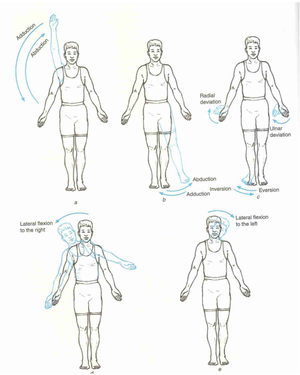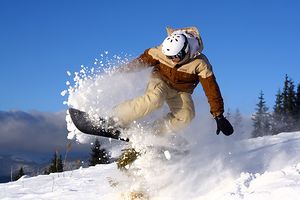Osteokinematics: Difference between revisions
No edit summary |
No edit summary |
||
| Line 6: | Line 6: | ||
== Introduction == | == Introduction == | ||
[[File:Movement in the frontal plane about the sagital axis.png|right|frameless]] | [[File:Movement in the frontal plane about the sagital axis.png|right|frameless]] | ||
Osteokinematics describes clear movements of [[bone]]<nowiki/>s which are visible from the outside. They are the gross movement that happens between two bones. They arise from rotation around the joint axis. | Osteokinematics describes clear movements of [[bone]]<nowiki/>s which are visible from the outside. They are the gross movement that happens between two bones. They arise from rotation around the [[Joint Classification|joint]] axis. | ||
Image 1: Movement in the frontal plane about the [[Cardinal Planes and Axes of Movement|sagittal axis]] | Image 1: Movement in the frontal plane about the [[Cardinal Planes and Axes of Movement|sagittal axis]] | ||
| Line 16: | Line 16: | ||
* Lateral rotation and medial rotation | * Lateral rotation and medial rotation | ||
Osteokinematics differs from [[arthrokinematics]]. In general Osteokinematics means bone movement and Arthrokinematics [[Joint Classification|joint]] movement ( represents the small movements happening at the joint surface itself. Movements are rolls, glides/slides, and spins).<ref>Sirola Training method Arthrokinematics and Osteokinematics Available:http://blog.sirolatrainingmethod.com/2019/10/arthrokinematics-and-osteokinematics/ (accessed 3 | Osteokinematics differs from [[arthrokinematics]]. In general Osteokinematics means bone movement and Arthrokinematics [[Joint Classification|joint]] movement ( represents the small movements happening at the joint surface itself. Movements are rolls, glides/slides, and spins).<ref>Sirola Training method Arthrokinematics and Osteokinematics Available from:http://blog.sirolatrainingmethod.com/2019/10/arthrokinematics-and-osteokinematics/ (accessed 3 May 2021)</ref> | ||
The video below gives a good 2 minute outline. | The video below gives a good 2 minute outline. | ||
| Line 28: | Line 28: | ||
For Physiotherapists it is critical to understand the movements for every joint in the human body and to know appropriate [[Range of Motion|ranges in different planes of motion]]. | For Physiotherapists it is critical to understand the movements for every joint in the human body and to know appropriate [[Range of Motion|ranges in different planes of motion]]. | ||
Our daily job is to evaluate our athletes or clients, how they move, how they create movement patterns. eg If a competing snow boarders ankle has lost range of dorsi-flexion we need to be aware: of optimal flexion/dorsi-flexion ranges in sagittal plane; how to assess this ranges; what alterations from normal the client; interventions on how to solve problems. | Our daily job is to evaluate our athletes or clients, how they move, how they create movement patterns. eg If a competing snow boarders ankle has lost range of dorsi-flexion we need to be aware: of optimal flexion/dorsi-flexion ranges in sagittal plane; how to assess this ranges; what alterations from normal the client has; interventions on how to solve problems. | ||
* Osteokinematics is something we need to be aware of in our athletes before the main part of the training starts, before we start to load the body with high intensity. Does everything move correctly today? Is this person ready to “go hard” from the structural and positional standpoint? | * Osteokinematics is something we need to be aware of in our athletes before the main part of the training starts, before we start to load the body with [[Physical Activity and Exercise Prescription|high intensity]]. Does everything move correctly today? Is this person ready to “go hard” from the structural and positional standpoint? | ||
* Arthokinematics, on the other hand, are especially important during training, and you need observe when clients start to lose efficiency with this small unnecessary extra movements at the joint area<ref>ouhsc education Arthrokinetics Available:https://ouhsc.edu/bserdac/dthompso/web/namics/arthkin.htm (accessed 3 | * Arthokinematics, on the other hand, are especially important during training, and you need observe when clients start to lose efficiency with this small unnecessary extra movements at the joint area<ref>ouhsc education Arthrokinetics Available from:https://ouhsc.edu/bserdac/dthompso/web/namics/arthkin.htm (accessed 3 May 2021)</ref>. | ||
== References == | == References == | ||
Revision as of 13:48, 4 May 2021
Original Editor - Lucinda hampton
Top Contributors - Lucinda hampton and Uchechukwu Chukwuemeka
Introduction[edit | edit source]
Osteokinematics describes clear movements of bones which are visible from the outside. They are the gross movement that happens between two bones. They arise from rotation around the joint axis.
Image 1: Movement in the frontal plane about the sagittal axis
Some examples are:
- Flexion and extension
- Abduction and adduction
- Lateral rotation and medial rotation
Osteokinematics differs from arthrokinematics. In general Osteokinematics means bone movement and Arthrokinematics joint movement ( represents the small movements happening at the joint surface itself. Movements are rolls, glides/slides, and spins).[1]
The video below gives a good 2 minute outline.
Application[edit | edit source]
Why we need to be aware of osteokinematics on daily basis?
For Physiotherapists it is critical to understand the movements for every joint in the human body and to know appropriate ranges in different planes of motion.
Our daily job is to evaluate our athletes or clients, how they move, how they create movement patterns. eg If a competing snow boarders ankle has lost range of dorsi-flexion we need to be aware: of optimal flexion/dorsi-flexion ranges in sagittal plane; how to assess this ranges; what alterations from normal the client has; interventions on how to solve problems.
- Osteokinematics is something we need to be aware of in our athletes before the main part of the training starts, before we start to load the body with high intensity. Does everything move correctly today? Is this person ready to “go hard” from the structural and positional standpoint?
- Arthokinematics, on the other hand, are especially important during training, and you need observe when clients start to lose efficiency with this small unnecessary extra movements at the joint area[3].
References[edit | edit source]
- ↑ Sirola Training method Arthrokinematics and Osteokinematics Available from:http://blog.sirolatrainingmethod.com/2019/10/arthrokinematics-and-osteokinematics/ (accessed 3 May 2021)
- ↑ My life Choice Osteokinematics VS Arthrokinematics Available from:https://www.youtube.com/watch?v=yzozxABe9S4 (accessed 3.5.2021)
- ↑ ouhsc education Arthrokinetics Available from:https://ouhsc.edu/bserdac/dthompso/web/namics/arthkin.htm (accessed 3 May 2021)








